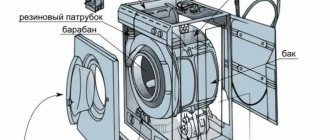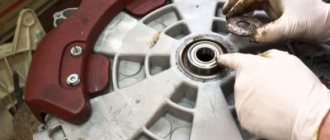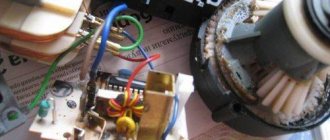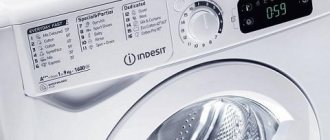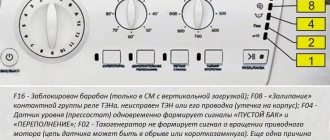All housewives have had problems with their washing machine breaking down at least once in their lives. And, as a rule, this is most often associated with a malfunction of the level relay, otherwise called the pressure switch of the washing machine. It is quite possible to fix this breakdown yourself at home.
What kind of part this is, what it is needed for, as well as what could be the reasons for its malfunction and how to eliminate them, is described below.
How to check the pressure switch (level switch) of a washing machine
- Operating principle and location of the pressure switch
- Signs of a malfunctioning pressure switch
- How to check the pressure switch of a washing machine
- Replacing the pressure switch
- Setting up the pressure switch
- Bottom line
The pressure switch, also known as a water level sensor, controls the amount of liquid in the tank and determines when it is necessary to stop the supply. If it is damaged, the machine will not know whether it needs to add water and, if so, to what level. It is easy to replace a broken fill sensor yourself if you know how it functions and where it is installed, as well as how to check the pressure switch of a washing machine yourself.
What is a pressure switch in a car?
This part is present in any brand of unit (Samsung, Ariston, Zanussi, Electrolux and other brands). For a washing machine, a pressure switch provides control of the level of water poured into the tank. Without a pressure switch, the device is not able to determine exactly how much water needs to be poured into the drum and whether it needs to be poured at all.
The sensor looks like a small round plastic part to which wires are connected. A tube coming from the high-pressure reservoir is attached to the controller. After collecting water in the tank, the pressure increases, the sensor of the Sandy or Electrolux washing machine is triggered and sends a signal to open (close) the relay contacts. If the device is faulty, repair and possibly replacement is necessary.
How to replace a sensor in a washing machine
Replacing the level sensor of a washing machine is carried out in several steps:
- Disconnect the device completely from the network, forcefully empty the drum and remove the laundry from it. Water is drained from the machine through a hose or filter. The listed measures are required for safety reasons.
- Unscrew the screws that hold the top cover, the part is located there. It looks like a round washer connected to the machine by several cables and a tube.
- Unscrew the 2 hex bolts from the back wall; they hold the panel, and the spare part is attached to it. Disconnecting the pressure switch is necessary to check its functionality and replace it.
- Remove the panel, photograph the location of the pressure switch and the wires connected to it. All elements and cables are connected according to the photo.
- Disconnect the terminals, wires, tube from the part. It is important to remove them carefully so as not to damage them.
- Install a new spare part in the same place. Be sure to reconnect the cables and tubes to their original places.
- Check the functionality of the sensor. To do this, the wash starts at idle.
Before replacing the pressure sensor in the washing machine, you can additionally check its functionality. Diagnostics is needed if, based on signs of breakdown, there is no certainty that this part is broken. To the place where there was a tube you need to connect a tube similar in diameter and blow into it. A working pressure switch makes clicks; a broken one does not respond to an increase in pressure.
Operating principle of the sensor
The operating principle of the water level switch of a washing machine is based on the effect of pressure on a special membrane (diaphragm). When water is drawn into the tank of the washing unit, water fills the compression chamber and pressure corresponding to the level of the collected water is injected into the sensor housing through a special tube.
The compression chamber is usually built into the drain pipe. The pipe itself is connected to the tank and the volute from the drain pump using special clamps. There are cameras soldered directly into the tank itself. It happens that these cameras become clogged with slurry and dirt over time!
When pressure is applied to the membrane, the contacts close and open, as a result of which a signal about incoming water is sent to the control module. There are several types of pressure switch: pneumatic (mechanical) or with an oscillating circuit (electronic), in this case the mechanical principle will be described. They are also divided into single-chamber and double-chamber.
Double-chamber pressure sensors are specially developed for washing machines with small and large loads. When the load is low, one membrane is activated and water is supplied in a minimum amount. When the drum is heavily loaded, the second membrane is activated, the contacts close and the control processor gives a command to supply the maximum amount of water.
As a rule, the membrane installed inside the sensor is made of rubber or elastic polymer and is designed for repeated on and off cycles. The operating principle of the pressure switch combines the sequential influence of air pressure on the mechanical part, above which the electrical contacts are located, and a direct electrical impulse on the control processor of the washing unit.
Finding and checking the level sensor
To check the pressure switch you do not need to have special knowledge. Even a beginner can cope with this task. The sequence of actions will be as follows:
- turn off the power to the washing machine;
- close the valve responsible for supplying water to the tank;
- remove the top cover of the case by unscrewing the screws holding it;
- find the liquid level switch;
- prepare a tube of a size similar to the diameter of the fitting;
- Disconnect the pressure hose, insert the prepared tube into it and lightly blow into it.
If the pressure switch is working properly, you should hear one or three soft clicks.
Then examine the part for damage. Inspect the hose for blockages and, if necessary, clean it with a stream of water from the tap.
When, after an external examination, no defects were identified, you will have to use a multimeter to further diagnose the sensor. Switch the device to resistance mode, connect the tester probes to the contacts of the pressure switch. If the value on the multimeter screen changes after the procedure, it means that the contacts are working perfectly; if the resistance value remains the same, the relay must be replaced.
Typical faults
The failure of the water level sensor is most often indicated by malfunctions:
- The washing cycle starts before the washing machine has filled with water. When the washing mode is turned on, the control module turns on the heating element to heat the water. Without water in the tank, the heating element will overheat and burn out.
- There is not enough or too much water for washing. The control module may not close the inlet valve due to a faulty pressure switch. This leads to the machine leaking and flooding the room.
- After spinning, the laundry remains wet. The water from the tank is not completely drained after the washing cycle.
- At the end of the session, the water does not leave the tank and the machine does not open the hatch. The pressure switch does not send a signal to the control module about the presence of water and the module does not turn on the drain pump.
- The washing machine does not work and shows an error code on the display. This is only possible in cars with self-diagnosis. Decipher the error code to find the broken part.
The adjustment did not give a positive result: what to do?
It is quite simple to independently determine that the pressure switch has failed - signs of its failure clearly confirm the problem. But adjusting the part does not always help - there are situations when a complete replacement of the part is required.
It will not take much time to install a new water control sensor. It is necessary to partially disassemble the equipment to gain access to the pressure switch. After this, remember the electrical wiring connection diagram, disconnect it from the contacts and remove the pressure switch. Further actions are performed in the following sequence:
- a new pressure switch is attached to the system, similar to the failed one;
- a hose is connected to the water control sensor tube and secured with a clamp;
- all connections must be checked for kinks, cracks and other damage;
- The wiring is connected according to a known scheme;
- assembly is performed in reverse order, the device is started to test for functionality.
Washing machine pressure switch device
The pressure switch device of a washing machine looks like a disk with an air chamber located inside, equipped with wires and a tube, the second end of which is located in the tank of the washing equipment.
The incoming liquid increases the air pressure both in the tube and in the pressure switch chamber.
In this regard, the rod rises, which presses on the contact plate under the spring. This happens until a certain amount of liquid is reached.
Then the electrical circuit of the relay input lamellas is closed due to the spring plate switching to the upper position.
When the water drains, the pressure decreases and the rod creeps down, which causes the relay to switch downwards, and the electrical circuit breaks. The module then transmits information and commands to the pump, heater, inlet valve and engine.
Consequences of operating a faulty sensor
If the water level sensor in the Lg washing machine or the pressure switch in the Siemens washing machine (Siemens) does not work correctly, you need to replace it with a new indicator.
Otherwise, the consequences will be as follows:
- Deterioration in wash quality due to too low water level in the tank;
- The device will turn on the heating element without water, which will lead to overheating of the element and its breakdown;
- Due to incomplete drainage of water after washing, the laundry will not be spun sufficiently.
If the wires and tube of the heating element overheat, this may cause the unit to catch fire. Therefore, repairs should be carried out on time.
How a washing machine controls the water level
A pressure switch is a small device with several wires on it, usually located under a cover on the top of the machine. This water level sensor in a washing machine can be an old type, mechanical, if the washing machine was made in the 90s, or a modern, electronic one, which is much smaller in size. However, any pressure sensor will always have a thin rubber or plastic tube attached to it, which connects to the pressure chamber so that air pressure can turn it on and off. Pressure chamber - the word seems inappropriate, but this is precisely a high-pressure reservoir, and in the future we will simply call it a tank.
Preliminary actions
As soon as you discover a malfunction, you should understand whether the reason actually lies in the part that controls the water level. It is necessary to carefully inspect the water intake system, check the sleeve and fitting of the water intake sensor, and the transition chamber section. When inspecting these parts, you should not find any tears or abrasions, as well as deposits from washing powder.
If detergent is detected on the parts, all components must be washed, after which a second attempt is made to start the washing machine. It is quite possible that you have restored the ability of the pressure switch to work.
Secondly, the correctness and strength of the electrical wiring connection to the part is checked. There is a possibility that one of the wires is worn out or bent. Having discovered such a defect, we eliminate it and perform a test run again.
Be sure to check the contact group of the pressure switch. If there is a deposit of dirt, clean it and again check the water intake sensor for serviceability.
Diagnostics is performed using a tube whose diameter matches the size of the part’s hose. We put one end of the tube on the instrument fitting, and blow into the second. If the part that controls the water intake is in good condition, light clicking sounds will be heard.
When this method of checking does not help identify problems, the pressure switch will have to be disassembled.
Prevention
In order for the pressure switch in the Ariston, Electrolux (Electrolux) washing machine to work for a long time and control the required pressure, it is recommended:
- Follow all operating instructions of the washing machine manufacturer;
- Eliminate the slightest malfunctions promptly and competently;
- Protect the unit from voltage surges in the network using special voltage stabilizers;
- Use hard water softeners;
- If the washing machine is still under warranty, it is better to have it repaired by a service center;
- Regularly check the drain hose filter for dirt, foreign objects, and deposits;
- Carry out a preventive examination and preventative washing once every 12 months;
- Repairing the washing machine pressure switch yourself should only be done if you have a certain level of knowledge and experience.
- How to wash a bathroom curtain
- How to remove glue from clothes
